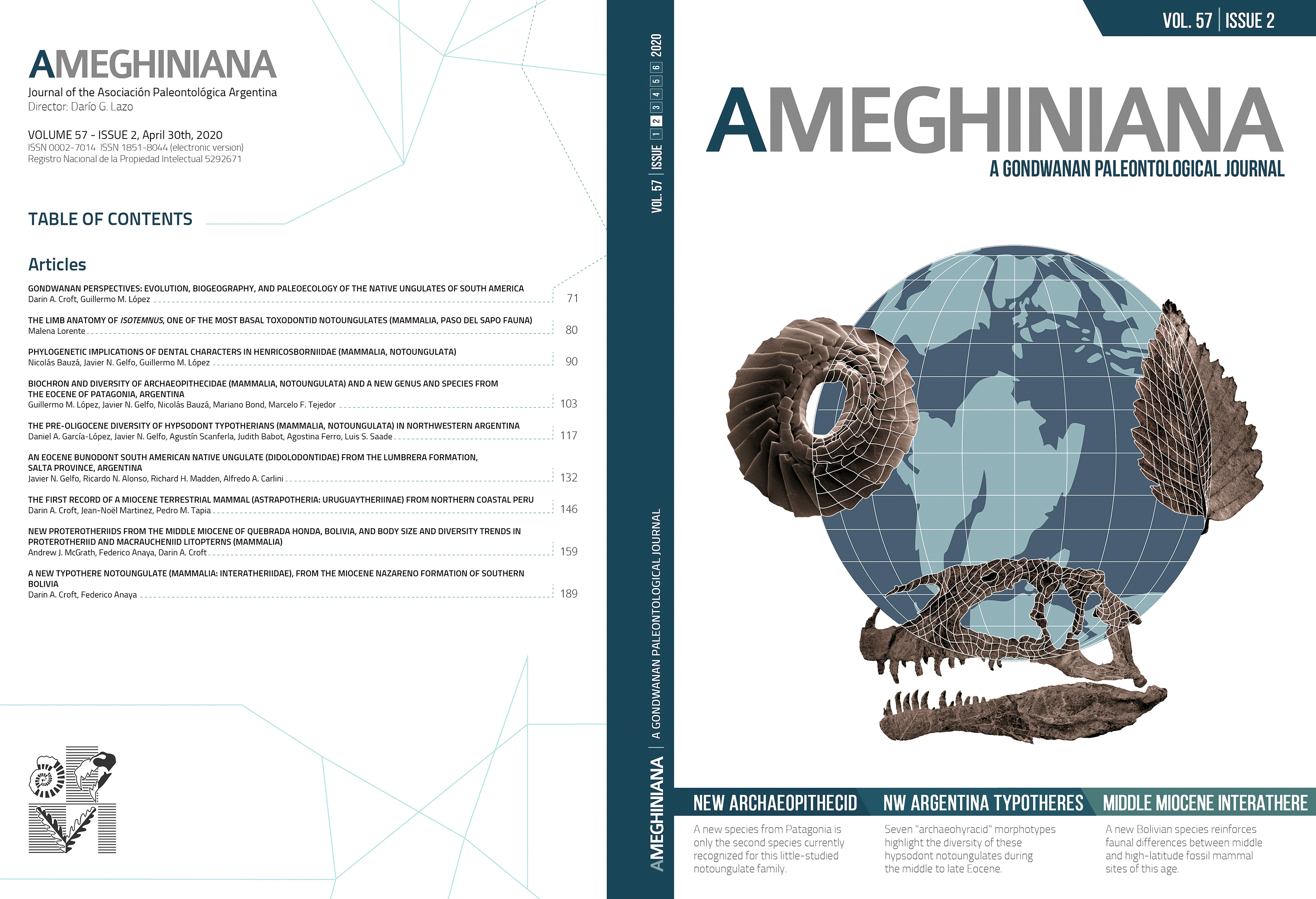NEW PROTEROTHERIIDS (LITOPTERNA, MAMMALIA) FROM THE MIDDLE MIOCENE OF QUEBRADA HONDA, BOLIVIA, AND TRENDS IN DIVERSITY AND BODY SIZE OF PROTEROTHERIID AND MACRAUCHENIID LITOPTERNS
DOI:
https://doi.org/10.5710/AMGH.03.03.2020.3268Keywords:
South America, Laventan, Ungulate, Proterotheriidae, Macraucheniidae, Body Size, Diversity, EvolutionAbstract
In this work, we describe two new species of proterotheriid litopterns, Olisanophus riorosarioensis gen. et sp. nov. and Olisanophus akilachuta sp. nov. from the middle Miocene (Laventan SALMA) of Quebrada Honda, Bolivia. When incorporated into a recently published phylogenetic analysis (40 taxa; 92 characters), they plot as sister taxa, partially supported by their connected metaconule and protocone on M3. Additionally, we revise the taxonomy of two contemporaneous proterotheriids from La Venta, Colombia. 'Prolicaphrium sanalfonensis' is reassigned to Olisanophus with a prominent protocone on M3 as a synapomorphy of the genus. We revalidate the genus Neodolodus for Neodolodus colombianus, a species previously referred to 'Prothoatherium' or Lambdaconus by others. We used the paleotree R package to examine evolutionary trends in diversity and body size (using m1 length as a proxy) in proterotheriid and macraucheniid litopterns in a phylogenetic context. Proterotheriids were more diverse in the Paleogene than their fossil record indicates; their diversity peaked in the early Miocene and gradually declined until the Pleistocene. Macraucheniids experienced two peaks in diversity, in the early and late Miocene, but were still fairly diverse in the Pleistocene, unlike proterotheriids. Multiple proterotheriid lineages became larger during the Paleogene, but body size was roughly static during the Neogene with no obvious link between phylogeny and size. Macraucheniids can be grouped into three size classes that are phylogenetically conserved and roughly correspond temporally to Eocene (Polymorphis spp.), Miocene–Pliocene (medium-sized ‘cramaucheniines’ and early macraucheniines, e.g., Theosodon, Promacrauchenia), and Pleistocene (large macraucheniines, e.g., Macrauchenia) species.Downloads
- Requires Subscription PDF
- Requires Subscription Supplementary Online Information
- Requires Subscription Supplementary Online Information
- Requires Subscription Supplementary Online Information
- Requires Subscription Supplementary Online Information
- Requires Subscription Supplementary Online Information
- Requires Subscription Supplementary Online Information
- Requires Subscription Supplementary Online Information
Published
Issue
Section
License
Authors publishing in Ameghiniana have the option of making their article freely available online. Authors opting for the Open Access must pay a fee of $300 (US dollars) to cover article-processing costs and to ensure the article is made open access. Please contact the Production Team after the acceptance of your manuscript if you are interested in making your article Open Access. This option implies by default a license Creative Commons Attribution Non-Commercial-NoDerivs License (CC BY NC ND). If your funding institution requires a different licensing option please communicate this to the Production Team after the acceptance of your manusctipt.











